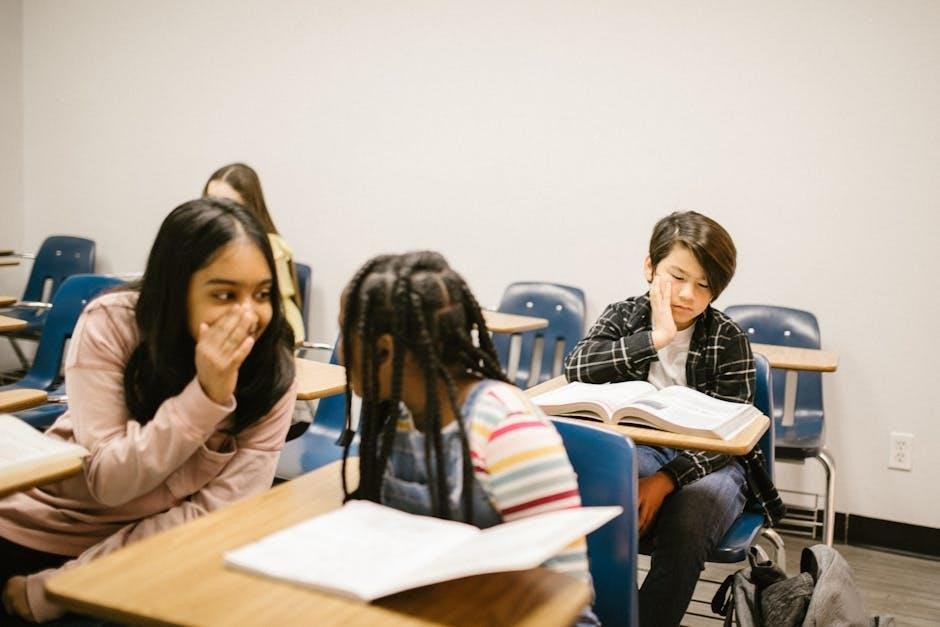This guide explores Markus Zusak’s The Book Thief, offering insights into themes, characters, and historical context to deepen understanding and spark meaningful discussions about the novel.
1.1 Overview of the Novel
The Book Thief, written by Markus Zusak, narrates the story of Liesel Meminger, a young girl growing up in Nazi Germany during WWII. The novel explores themes of hope, humanity, and the power of words through Liesel’s journey, her relationships, and the harrowing backdrop of war. Death serves as the unique narrator, offering a haunting yet poetic perspective on life and loss.
1.2 Author Background: Markus Zusak
Markus Zusak, an Australian author, gained acclaim for The Book Thief, which reflects his passion for storytelling and historical narratives. Born in 1975, Zusak draws inspiration from his parents’ European heritage, crafting emotional tales that resonate globally, earning him multiple awards and a dedicated readership.

Unique Narrative Style
The novel features Death as a narrator, offering a poignant and hauntingly beautiful perspective that uniquely engages readers with the story’s emotional depth and historical significance.
2.1 Death as the Narrator
Death, the unconventional narrator, guides readers through the story with a unique voice, blending dark humor and empathy. This perspective humanizes Death, making it relatable while emphasizing the novel’s themes of mortality and hope. Death’s observations and interactions with Liesel add depth, transforming a grim subject into a powerful exploration of human resilience and the beauty of life.
2.2 Impact of the Narrative Voice on Storytelling
The narrative voice in The Book Thief elevates the story, offering a unique perspective that blends introspection and emotional depth. Death’s narration adds complexity, creating a sense of detachment while fostering empathy. This unconventional voice underscores the novel’s themes, making the storytelling both haunting and poignant, and allowing readers to connect deeply with the characters and their experiences during wartime Germany.

Major Themes in “The Book Thief”
The Book Thief explores themes like the transformative power of words, hope amidst adversity, and humanity’s moral struggles, each enriching the narrative with profound depth and emotional resonance.
3;1 The Power of Words and Literature
In The Book Thief, words and literature serve as both weapons and tools for change. Liesel’s journey highlights how language can inspire hope, challenge oppression, and foster human connection, emphasizing its dual power to harm or heal in a world torn apart by hatred and fear.
3.2 Hope and Resilience in the Face of Adversity
Liesel and the characters in The Book Thief embody hope and resilience amidst war and oppression. Through small acts of defiance, like stealing books or sharing kindness, they find strength to endure. The novel illustrates how hope, though fragile, sustains humanity during even the darkest times, offering a powerful message of survival and the human spirit’s capacity to persevere.
3.3 Humanity and Moral Dilemmas
The Book Thief delves into the complexities of humanity through characters’ moral dilemmas. Hans and Rosa’s decision to hide Max, a Jewish man, highlights courage amidst oppression. Liesel’s book-stealing symbolizes resistance. These choices underscore the struggle between conformity and conscience, illustrating how ordinary people navigate extraordinary ethical challenges during wartime, revealing the depth of human compassion and sacrifice.
Key Characters and Their Development
Liesel, Hans, Rosa, and Max are pivotal characters whose evolving relationships and personal growth drive the emotional depth and moral complexity of the story.
4.1 Liesel Meminger: The Protagonist
Liesel, a young girl in Nazi Germany, discovers the power of words and literature. Her journey from illiteracy to becoming a book thief highlights her resilience and growth amidst war, showcasing her transformation into a symbol of hope and defiance in a world torn apart by conflict and oppression.
4.2 Hans and Rosa Hubermann: Foster Parents
Hans and Rosa Hubermann, Liesel’s foster parents, provide love and protection in a tumultuous world. Hans, with his kind heart and gentle ways, teaches Liesel the beauty of words and humanity, while Rosa’s tough exterior hides a deep love, shaping Liesel’s understanding of family and resilience in the face of Nazi oppression.
4.3 Max Vandenburg: The Jewish Fighter
Max Vandenburg, a Jewish boxer forced into hiding, finds refuge with the Hubermanns. His friendship with Liesel is built on shared struggles and stories, symbolizing resilience and hope. Max’s presence highlights the human cost of Nazi oppression and the moral courage of those who risk everything to protect him, leaving a lasting impact on Liesel’s life.

Symbolism in the Novel
The novel richly employs symbols like books, colors, and the accordion to convey deeper meanings, enhancing themes of hope, survival, and the human condition during wartime.
5.1 The Significance of Books and Reading
Books and reading symbolize knowledge, escape, and resistance in The Book Thief. Liesel’s love for words empowers her, while stolen books represent defiance against oppression. Reading becomes a lifeline, fostering hope and understanding amidst the chaos of war, highlighting literature’s enduring power to inspire and transform lives.
5.2 Color Symbolism: White, Black, and Red
White symbolizes purity and death, often representing innocence lost. Black embodies mourning and the unknown, yet also serves as a backdrop for hope. Red, vibrant and life-affirming, signifies love, sacrifice, and humanity’s resilience, contrasting starkly with the darkness of war, and reminding us of life’s enduring power amidst despair.

Historical Context: World War II and Nazi Germany
The novel is set in 1930s-1940s Germany, exploring life under the Nazi regime, the horrors of war, and the resilience of ordinary people amidst oppression and destruction.
6.1 The Setting: 1930s-1940s Germany
The novel is set in Nazi Germany during the 1930s and 1940s, a time of immense turmoil. The setting vividly portrays life under Hitler’s regime, highlighting the fear, propaganda, and oppression that permeated society. The war-torn streets of Molching serve as a backdrop for the story, illustrating the harsh realities of World War II and its impact on ordinary civilians.
6.2 The Impact of War on Civilians
The novel vividly portrays the devastating effects of war on ordinary people. Civilians faced constant fear, loss, and moral dilemmas, as seen through Liesel’s experiences. The war disrupted families, forced difficult choices, and exposed the brutality of Nazi rule. Yet, amidst the chaos, acts of kindness and resilience highlight the enduring humanity in the face of unimaginable suffering.

Moral and Ethical Questions
The novel raises profound moral dilemmas, such as stealing for survival and hiding Jews during the Holocaust, challenging characters to confront their beliefs and humanity in dire circumstances.
7.1 Stealing as a Moral Dilemma
Stealing becomes a central moral conflict in The Book Thief, as Liesel faces the choice between survival and theft. Her actions challenge traditional notions of right and wrong, emphasizing that stealing can be both a sin and a necessary act of resilience in desperate times, reflecting the complexities of human morality during war.
7.2 The Ethics of Hiding Jews During the Holocaust
Hiding Jews during the Holocaust, as depicted through Max Vandenburg’s character, raises profound ethical questions. The Hubermanns’ actions highlight the moral courage required to defy oppressive regimes, emphasizing the importance of compassion and humanity over conformity to unjust laws, despite the immense personal risks involved.
The Novel’s Impact and Reception
The Book Thief has received widespread acclaim for its emotional depth and unique storytelling. It has won multiple awards, been translated into numerous languages, and resonated deeply with readers worldwide, sparking important conversations about humanity and history.
8.1 Critical Acclaim and Awards
The Book Thief has garnered significant critical acclaim, earning the Michael L. Printz Honor and the Book Sense Book of the Year award. Its unique narrative and emotional depth have captivated readers and critics alike, solidifying its place as a modern literary classic and a powerful exploration of humanity during wartime.
8.2 Reader Responses and Cultural Significance
Readers worldwide have connected deeply with The Book Thief, praising its emotional resonance and thought-provoking themes. The novel’s cultural significance lies in its ability to humanize historical events, fostering empathy and reflection. It has become a cherished read in classrooms and homes, sparking vital discussions about humanity, hope, and the enduring power of words.

Reading Schedule and Discussion Plan
This section provides a structured plan for reading and discussing The Book Thief, ensuring a engaging and thought-provoking experience for readers of all ages.
9.1 Weekly Reading Assignments
Divide the novel into weekly sections, allowing readers to digest major themes and events. Assign chapters 1-5 for week one, focusing on Liesel’s arrival and initial experiences. Weeks two and three cover the deepening relationships and challenges. The final week explores the climax and resolution, ensuring a comprehensive understanding of the narrative arc. This structured approach facilitates meaningful discussions and reflections. Use provided summaries to guide reading and prepare for debates. Ensure participants have time to analyze key moments, fostering a deeper connection with the story and its themes. This method encourages active engagement and thorough exploration of the text, enhancing the overall learning experience. By following this plan, readers can systematically uncover the novel’s richness and complexity. The structured schedule supports a balanced pace, preventing overwhelm and allowing space for thoughtful analysis. Each week’s assignment builds upon the previous, creating a cohesive journey through the story. This approach ensures that all major elements are covered, from character development to thematic depth. The assignments are designed to promote critical thinking and shared insights, enriching the collective understanding of The Book Thief. Encourage participants to jot down questions and observations for lively discussions. The weekly structure also helps in tracking progress, making it easier to revisit key sections. Overall, this plan offers a clear roadmap for engaging with the novel, ensuring a rewarding experience for all participants.
9.2 Facilitating Effective Discussions
Encourage open dialogue by creating a safe, respectful environment. Use open-ended questions to prompt critical thinking and personal reflections. Actively listen to participants, ensuring diverse perspectives are heard. Summarize key points to maintain focus and guide the conversation. Balance structure with flexibility, allowing discussions to evolve naturally. Provide opportunities for participants to share insights and connect themes to real-life experiences. Foster collaboration and empathy through thoughtful facilitation, ensuring all voices contribute meaningfully to the exploration of The Book Thief.
Discussion Questions and Prompts
Explore themes, characters, and moral dilemmas through engaging questions. How do Liesel’s actions reflect hope? What motivates Hans’s kindness? Discuss the symbolism of stealing books; Analyze the ethical choices, fostering deeper connections to the story and its relevance.
10.1 Character Motivations and Relationships
Analyze Liesel’s desire for knowledge and her foster parents’ influence. Discuss Hans’s compassion and Rosa’s tough yet nurturing nature. Explore Max’s impact on Liesel and the moral dilemmas he faces. Consider how relationships shape their choices and resilience, highlighting the emotional depth of their connections amidst war’s challenges. How do these bonds reflect hope and humanity?
10.2 Thematic Analysis and Personal Reflection
Reflect on the novel’s themes, such as hope, words’ power, and humanity. Consider how these resonate personally, especially in times of adversity. Discuss the moral dilemmas characters face and how their choices inspire resilience. Encourage readers to connect the story’s messages to their own lives, fostering a deeper understanding of its universal themes and emotional impact.
Writing Prompts for Deeper Engagement
Explore creative writing inspired by the novel, such as imagining an alternate ending or crafting a diary entry from a character’s perspective. Reflect on personal connections to themes like hope and resilience, fostering a deeper understanding of the story’s emotional and moral layers.
11.1 Creative Writing Inspired by the Novel
Engage with creative writing prompts that draw inspiration from The Book Thief. Imagine an alternate ending, craft a poem reflecting the novel’s themes, or write a scene from a minor character’s perspective. These exercises encourage readers to explore the story’s emotional depth and moral complexities while fostering personal connections to the narrative.
11.2 Reflective Essays on Key Themes
Explore the profound themes of The Book Thief through reflective essays. Analyze hope, resilience, and humanity amidst war, or the power of words in shaping experiences. Reflect on personal connections to these themes, encouraging deeper understanding and fostering a meaningful connection to the narrative and its universal messages.

Resources for Further Exploration
Discover supplementary materials, including documentaries, historical archives, and educational websites, to deepen your understanding of The Book Thief and its historical context.
12.1 Recommended Reading List
Enhance your understanding of The Book Thief with books like The Diary of a Young Girl by Anne Frank and Man’s Search for Meaning by Viktor Frankl. These works provide deeper insights into the Holocaust, resilience, and the human condition. Additionally, explore historical non-fiction such as The Rise and Fall of the Third Reich for context on Nazi Germany.
12.2 Historical and Cultural Resources
Explore historical resources like the United States Holocaust Memorial Museum and Yad Vashem for primary documents and personal stories. Cultural resources include documentaries, films, and academic articles on WWII. Visit online archives for access to historical newspapers, propaganda materials, and artifacts. These resources provide a deeper understanding of Nazi Germany’s cultural and historical context, enriching your discussion of The Book Thief.
This guide concludes with a reflection on the novel’s profound themes. Encouraging readers to explore its historical and cultural significance further, fostering ongoing engagement with its timeless messages.
13.1 Summarizing Key Takeaways
The Book Thief masterfully intertwines historical fiction with poignant themes. It highlights the power of words, resilience, and humanity amidst war. Liesel’s journey underscores hope and moral courage, leaving readers with a profound appreciation for literature’s impact and a deeper understanding of WWII’s human toll, encouraging reflection on ethical dilemmas and personal growth.
13.2 Encouraging Ongoing Exploration of Themes
Encourage readers to reflect on the novel’s themes beyond the discussion guide. Explore how The Book Thief relates to personal experiences, fostering empathy and critical thinking. Suggest further reading, writing, or discussions to deepen understanding of its universal messages, ensuring the story’s impact endures and inspires continued exploration of its rich, thought-provoking ideas.
